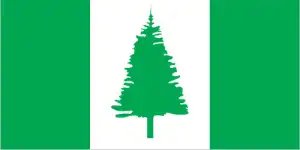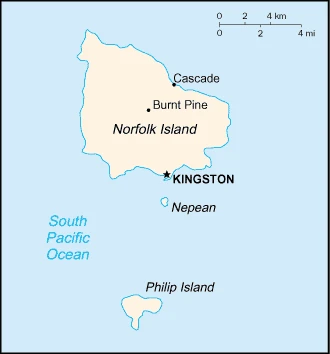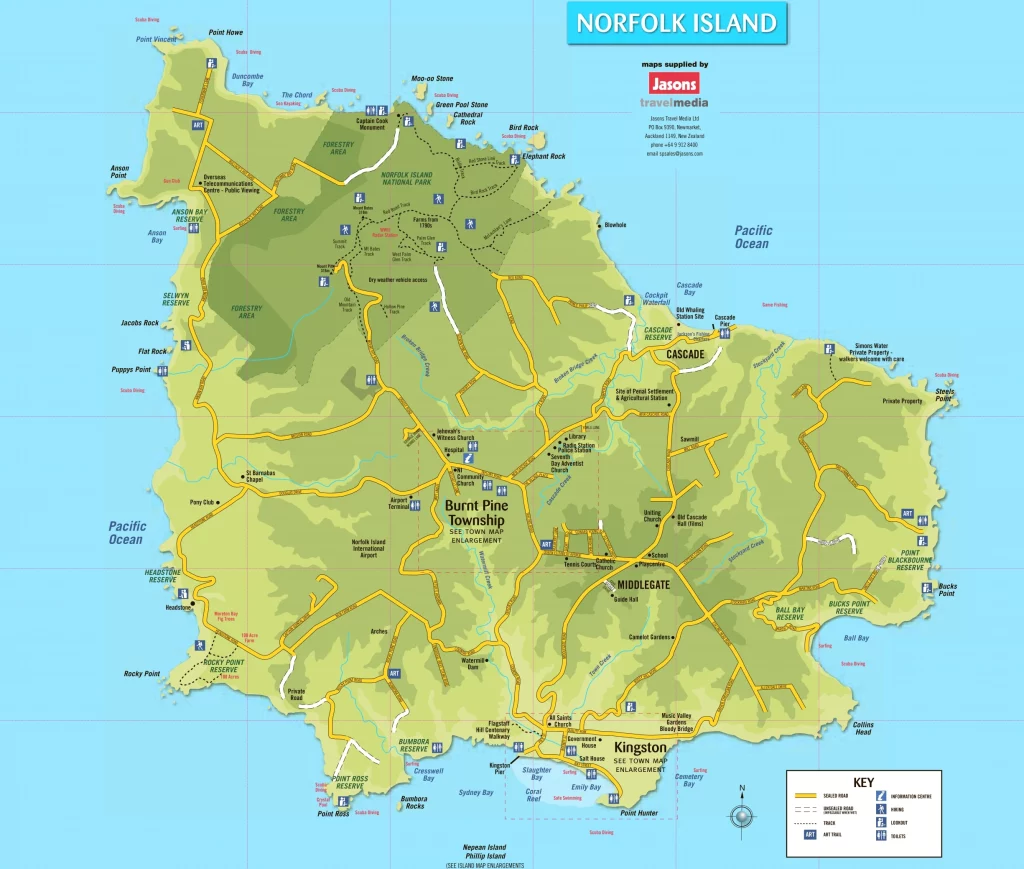Norfolk Island Google Maps is a site/tool that offers a wide range of map views (topographic, satellite, street view) and navigation options, with little effort on your part, yet efficiently. If you need to plan a trip to a new place like Norfolk Island, Google maps are available on desktop, mobile, or tablet. This Google maps and information page is dedicated to Norfolk Island, Oceania, showing its location, country facts, details about its capital city Kingston, and plenty of other information which may be interesting when you visit this Oceanian state.
Quick links: Google Maps Norfolk Island, Skopje Google maps, Driving Directions Norfolk Island, Printable Road Map.

About Norfolk Island in a nutshell
- Conventional short form of the name: Norfolk Island
- The conventional long form of the name: conventional long form: Territory of Norfolk Island
- The legal system in Norfolk Island: English common law and the laws of Australia.
- Climate: Tropical cyclones (especially May to July).
- The national symbols are Norfolk Island pine.
- Internet TLD: .nf
Norfolk Island is a small island in the Pacific Ocean. It is part of New Zealand, but it has its laws and government. Polynesian people initially inhabited the island, bringing animals such as coconut crabs, wallabies, and kangaroos. In 1856, the British colonized the island, and it became an important port for whaling ships.
Norfolk Island is in the Pacific Ocean and 900 KM from Lord Howe Island. It is an external territory of Australia and has 1748 inhabitants living on 35km2 of land. Norfolk Island is a semi-autonomous Australian territory that is situated in the Pacific Ocean between Australia and New Zealand. It’s about 400 miles from New Caledonia. The island first served as a penal colony to house convicts. Settlers were relocated from Pitcairn Island, and the convict population was relocated here in 1856. The UK government gave over Norfolk Island to Australia in 1914 to use this island as a territory, where it still serves as a penal colony.
Background
Polynesians lived on Norfolk Island between 1200 and 1500, but the remote island was uninhabited when British explorer James COOK landed on the island in 1774. Two British attempts at establishing the island as a penal colony (1788-1814 and 1825-55) were ultimately abandoned. In 1856, almost 200 Pitcairn Islanders – descendants of the Bounty mutineers and their Tahitian companions – were relocated to Norfolk Island because of overcrowding on the Pitcairn Islands. Some returned to the Pitcairn Islands over the next few years, but most settled permanently on Norfolk Island and recreated their previously-tenured land and governance structures.
Norfolk Island retained a great degree of local control until 1897 when it became a dependency of New South Wales. During World War II, Norfolk Island was an airbase and a vital refueling stop in the South Pacific. In 1976, an Australian judge recommended that Norfolk Island be incorporated fully into Australia, which Norfolk Islanders rejected. Following an appeal to the UN, Australia granted limited self-government to Norfolk Island in 1979. With growing financial troubles during the 2000s, Australia abolished the Norfolk Island Legislative Assembly in 2015, reduced Norfolk Islands autonomy in 2016, and suspended the local council in 2020. Most services are provided by a mix of the Australian Capital Territory and the states of New South Wales and Queensland. These moves were unpopular on Norfolk Island, which has sought to have its self-government restored.
Geography

Norfolk Island is an Australian territory in the Pacific Ocean 1,360 kilometers east of New Zealand. It has been a self-governing state since 1978, but it continues to be represented by New Zealand in specific international organizations. Norfolk Island is one of the most isolated places on Earth and is dubbed “the last place you can be alone on Earth.”
This state is located in Oceania, an island in the South Pacific Ocean, east of Australia, under the coordinates of 29 02 S, 167 57 E, covering an area of 25,713 sq km with a coastline of 32 km. Norfolk Island is About 0.2 times the size of Washington, DC.
A volcanic island with primarily rolling plains, with Mount Bates 319 m as the highest point of Norfolk Island, while the Pacific Ocean 0 m as the lowest point.
Most of the 32 km coastline consists of almost inaccessible cliffs, but the land slopes down to the sea in a tiny southern area on Sydney Bay, where the capital of Kingston is situated.
The climate in Norfolk Island is as follows: Subtropical, mild, slight seasonal temperature variation.
When you visit Norfolk Island, the natural hazards shall be considered: Tropical cyclones (especially May to July).
The following major health-threatening issues shall be considered when visiting Norfolk Island: none.
Current environmental issues affecting the Norfolk Islander(s) people: inadequate solid waste management; most freshwater obtained through rainwater catchment; preservation of the unique ecosystem.
Google Maps Norfolk Island
The capital and other divisions
Capital city: Kingston found under the coordinates 29 03 S, 167 95 E, applying the time zone UTC+11, using the following daylight saving time: +1hr, begins last Sunday in March; ends last Sunday in October.
Norfolk Island became independent of none (territory of Australia), and its national holiday is Bounty Day (commemorates the arrival of Pitcairn Islanders), 8 June (1856).
Administrative divisions: none (territory of Australia).
People and society
The population in Norfolk Island is 1,748 (2016 estimate), with an average of 0.01% (2014 estimate) change. That means Norfolk Island is the No. 232 in the world’s populated rank list.
The people living in this country are the noun: Norfolk Islander(s) (noun) or Norfolk Islander(s) (adjective) and belong mainly to the following ethnic groups: Australian 22.8%, English 22.4%, Pitcairn Islander 20%, Scottish 6%, Irish 5.2%.
They speak English (official language) 44.9%, Norfolk (also known as Norfuk or Norfk, which is a mixture of 18th century English and ancient Tahitian) 40.3%, Fijian 1.8%, other 6.8%, unspecified 6.2% (2016 estimate) languages and practice the following religions: Protestant 46.8% (Anglican 29.2%, Uniting Church in Australia 9.8%, Presbyterian 2.9%, Seventh Day Adventist 2.7%, other 2.2%), Roman Catholic 12.6%, other Christian 2.9%, other 1.4%, none 26.7%, unspecified 9.5% (2016 estimate).
We can conclude the following about the population in Norfolk Island: Population concentrated around the capital of Kingston.
Industry
Norfolk Island is suffering from a severe economic downturn. Tourism, the primary economic activity, is the main driver of economic growth. The agricultural sector has become self-sufficient in the production of beef, poultry, and eggs.
Norfolk Island is rich in the following natural resources: Fish.
The main industrial sectors are typically tourism, light industry, and ready-mixed concrete.
The country’s export sectors are particularly strong in soybean meal, Norfolk Island pine seeds, Kentia palm seeds, activated carbon, centrifuges, pesticides, postage stamps (2019), partnering with these nations: Philippines 29%, Singapore 21%, India 14%, Belgium 7%, Australia 5%, Canada 5% (2019).
Land use in Norfolk Island: 39.8% (2018 estimate) forest, 15.9% (2018 estimate) other.
The arable land area is 16.4% (2018 estimate), and the agricultural land is 44.3% (2018 estimate). Land use for permanent crops 1.4% (2018 estimate), permanent pasture 26.5% (2018 estimate). The sum of the area of the irrigated land is 0 sq km (2012).
The main agro-industrial products of Norfolk Island are Norfolk Island pine seed, Kentia palm seed, cereals, vegetables, fruit, cattle, and poultry.
The country typically needs to import: clothing and apparel, chemical analysis instruments, refined petroleum, cars, kitchen machinery (2019), partnering with the following nations: New Zealand 23%, Australia 19%, Philippines 19%, Singapore 14%, Fiji 11% (2019).
Norfolk Island Driving Directions
In this post, you learned about Norfolk Island, Oceania, east of Australia. We published some basic information about its capital Kingston, and the Norfolk Islander(s) nation.
Are you interested in visiting Norfolk Island and looking for driving directions? Click here to plan your route, or see a printable road map of Norfolk Island below for an overview of the route network.
Printable map of Norfolk Island
Did you know about Norfolk Island?
Norfolk Island is a small island in the Pacific Ocean. It’s home to about 1700 people, mainly descendants of the Bounty mutineers and their Tahitian wives. There’s an economy based on tourism, exporting pineapples and banana chips, and importing supplies.
After virtually visiting Norfolk Island, you may also be interested in the neighboring country: Australia.
If you liked our Google map and Norfolk Island information page,
please share it with others or save the link https://www.drivingdirections.net in your bookmarks.

